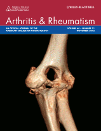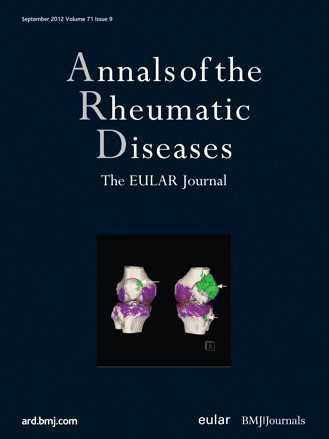Arthritis Rheum:感染牙龈卟啉单胞菌或增加罹患RA风险
2013-01-06 Arthritis Rheum 中华风湿网
目的:旨在探讨牙龈卟啉单胞菌与类风湿关节炎(RA)高风险人群出现自身抗体之间的关系。 方法:研究对象包括:1)携带HLA-DR4的人群和2)一级亲属为RA患者的RA高风险人群。所有这些研究对象均不符合1987年ACR的RA分类标准。需检测的自身抗体包括抗瓜氨酸化蛋白抗体(ACPA;ELISA法)和类风湿因子(RF;浊度测定法或ELISA法检测IgA,IgM或IgG亚型抗体)。检测到
目的:旨在探讨牙龈卟啉单胞菌与类风湿关节炎(RA)高风险人群出现自身抗体之间的关系。
方法:研究对象包括:1)携带HLA-DR4的人群和2)一级亲属为RA患者的RA高风险人群。所有这些研究对象均不符合1987年ACR的RA分类标准。需检测的自身抗体包括抗瓜氨酸化蛋白抗体(ACPA;ELISA法)和类风湿因子(RF;浊度测定法或ELISA法检测IgA,IgM或IgG亚型抗体)。检测到>1个RA相关自身抗体的个体被认为是自身抗体阳性个体(n=113);如ACPA或>2实验检测的RF阳性个体可被进一步分类为RA的高危人群(n=38)。自身抗体阴性的个体作为对照组(n=171)。检测抗牙龈卟啉单胞菌、中间普雷沃菌、具核梭杆菌抗体。应用逻辑回归的方式评估细菌抗体与不同分组之间的相关性。
结果:自身抗体阳性组和RA高风险组中抗牙龈卟啉单胞菌抗体的浓度高于自身抗体阴性组。抗中间普雷沃菌抗体或抗具核梭杆菌抗体浓度在各组间均没有差异。经多变量调整后抗牙龈卟啉单胞菌抗体的浓度(而不是抗中间普雷沃菌抗体或抗具核梭杆菌抗体)与自身抗体阳性和RA高风险状态显著相关。
结论:牙龈卟啉单胞菌的免疫原性与RA高风险人群中RA相关性自身抗体的出现显著相关。这些结果支持了这一假说:牙龈卟啉单胞菌的感染在RA发病早期的自身抗原免疫失耐受过程中发挥了重要作用。

Objective
To examine the relationship of Porphyromonas gingivalis to the presence of autoantibodies in individuals at risk of rheumatoid arthritis (RA).
Methods
Study participants included the following: 1) a cohort enriched in subjects with HLA–DR4 and 2) subjects at risk of RA by virtue of having a first-degree relative with RA. None of the study subjects satisfied the American College of Rheumatology 1987 classification criteria for RA. Autoantibodies measured included anti–citrullinated protein antibody (ACPA; by second-generation anti–cyclic citrullinated peptide antibody enzyme-linked immunosorbent assay [ELISA]) and rheumatoid factor (RF; by nephelometry or ELISA for IgA, IgM, or IgG isotype). Individuals were considered autoantibody positive (n = 113) if they had ≥1 RA-related autoantibody; individuals were further categorized as high risk (n = 38) if they had ACPA or positive findings ≥2 assays for RF. Autoantibody-negative individuals (n = 171) served as a comparator group. Antibody to P gingivalis, P intermedia, and F nucleatum were measured. Associations of bacterial antibodies with group status were examined using logistic regression.
Results
Anti–P gingivalis concentrations were higher in high-risk (P = 0.011) and autoantibody positive group (P = 0.010) than in the autoantibody negative group. There were no group differences in anti–P intermedia or anti–F nucleatum concentrations. After multivariable adjustment, anti–P gingivalis concentrations (but not anti–P intermedia or anti–F nucleatum) were significantly associated with autoantibody-positive and high-risk status (P < 0.05).
Conclusion
Immunity to P gingivalis, but not P intermedia or F nucleatum, is significantly associated with the presence of RA-related autoantibodies in individuals at risk of RA. These results support the hypothesis that infection with P gingivalis may play a central role in the early loss of tolerance to self antigens that occurs in the pathogenesis of RA.
本网站所有内容来源注明为“williamhill asia 医学”或“MedSci原创”的文字、图片和音视频资料,版权均属于williamhill asia 医学所有。非经授权,任何媒体、网站或个人不得转载,授权转载时须注明来源为“williamhill asia 医学”。其它来源的文章系转载文章,或“williamhill asia 号”自媒体发布的文章,仅系出于传递更多信息之目的,本站仅负责审核内容合规,其内容不代表本站立场,本站不负责内容的准确性和版权。如果存在侵权、或不希望被转载的媒体或个人可与williamhill asia 联系,williamhill asia 将立即进行删除处理。
在此留言










#Arthritis#
48
#ART#
71
#牙龈卟啉单胞菌#
50